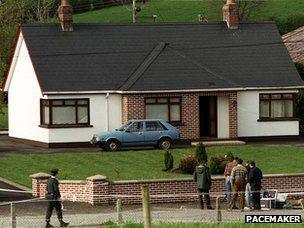Roseann Mallon inquest hears of 'Army lockdown'
- Published
Roseann Mallon was shot dead by the UVF in 1994
The Army had in "lockdown" a three-mile area around a house where a pensioner was killed by the UVF in 1994, an inquest into her death has heard.
Roseann Mallon, 76, was killed when loyalist gunmen opened fire on her sister-in-law's house near Dungannon.
Anthony McGonnell, who was an SDLP councillor at the time, said groups of armed men in combat gear were a regular feature in the area.
He said that this activity stopped after Ms Mallon was murdered.
The murder is surrounded in controversy because it later emerged that the Army was conducting a surveillance operation on a nearby house owned by Ms Mallon's nephew.
Mr McGonnell, when asked if he was referring to the Army, said he was "by and large", although they were not instantly recognisable.
'Murder triangle'
He said he had received complaints from local farmers who said their land was being used.

Roseann Mallon was shot dead in the living room of her sister-in-law's home
In the two weeks leading up to Ms Mallon's murder, eight people had been killed, and he was asked if he thought the increased activity by the security forces was connected to this.
He said the area was in a "form of lockdown" where it was impossible to move within a three-mile radius without being stopped by Army patrols.
This was "murder triangle" where non-combatants like Ms Mallon were killed, he told the court, adding that this all ended after she was killed.
He also gave evidence about an "Army lookout post" in a wooded area on higher ground, which he said farmers and landowners knew about.
The coroner asked whether it was possible this was a resting point for patrols working long periods. He agreed it could have been, but it could also have been used as a vantage point.
Fr James Crowley, who administered last rites to Ms Mallon, appeared at the inquest where a statement he made in 1994 was read out in which he described Ms Mallon as a "lovely person".
He said that after the murder, police had visited Protestant neighbours and told them they were "under threat".
Fr Crowley, along with Mr McGonnell, had contacted them to reassure them as he was concerned about the impact the murder could have on the community.
Derelict building
The inquest is also looking at whether there is a link to the discovery of an Army surveillance camera close to the murder scene.
The Old Mill incident refers to a sighting of army packs and guns in a shed beside the derelict building.
Gareth Loughran, who was 10 at the time of the murder, told the inquest on Tuesday he had seen this stash in the old mill but police had made him change his statement.
Witness Hugh Bennett, who spoke to the boys outside the shed, cast doubt on this account on Wednesday.
He told the inquest he had used the shed as a base while he was out fishing and shooting, and his camouflaged rucksack would have been in the shed at the time.
"I can only speculate they thought spades, brushes and shovels were guns," he said.
The case was among 29 controversial Troubles-related inquests which for years had been awaiting a full hearing.
The inquest is scheduled to last for two weeks
- Published5 November 2013
- Published4 November 2013